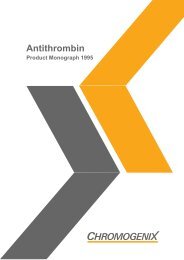Plasminogen - Chromogenix
Plasminogen - Chromogenix
Plasminogen - Chromogenix
Create successful ePaper yourself
Turn your PDF publications into a flip-book with our unique Google optimized e-Paper software.
streptokinase as an activator, is the overestimation<br />
that may occur in patients with elevated fibrin(ogen)<br />
degradation products (FDP) which stimulate the<br />
assay reaction. 54 The source of error can be overcome<br />
by the addition of plasminogen-free human<br />
fibrinogen in excess, thereby achieving the maximum<br />
stimulation of the streptokinase-plasminogen<br />
complex for all samples. 55 This approach is employed<br />
successfully in the COAMATIC ® <strong>Plasminogen</strong><br />
kit.<br />
The two major forms of plasminogen in plasma<br />
(i.e. Glu-plasminogen and Lys-plasminogen) can be<br />
measured using a chromogenic method based on the<br />
different rate of activation of the two forms of<br />
urokinase. 56<br />
Clot lysis time<br />
The activity of plasminogen can also be determined<br />
by means of various coagulation tests with casein or<br />
fibrin as the substrate (Figure 9). A typical assay<br />
would involve activation of plasminogen to plasmin<br />
by streptokinase or u-PA, the addition of plasminogen-free<br />
thrombin and measuring the lysis time. The<br />
principle is very simple although it has some major<br />
disadvantages, due mainly to the interference from<br />
the plasmin inhibitor which rapidly inactivates<br />
plasmin.<br />
Immunological assays<br />
The concentration of plasminogen can be measured<br />
by its antigenicity. Since the normal antigen concentration<br />
of plasminogen is between 150 and 250 ng/l<br />
the test can be performed using simple methods with<br />
moderate sensitivity such as radial immunodiffusion<br />
(Figure 10). 57 The main disadvantage is the 24-hour<br />
time lapse before results can be obtained.<br />
More rapid and sensitive methods are immunoelectrophoresis58<br />
or laser nephelometry, 59 with results<br />
obtained within 2 hours. A radioimmunoassay can<br />
also be used, which has a very high level of sensitivity<br />
but requires the handling of radioactive substances.<br />
60<br />
<strong>Plasminogen</strong>, version 1.1<br />
Assay methods<br />
11<br />
1. <strong>Plasminogen</strong> Activator<br />
Plasmin<br />
2. Addition of thrombin for clot formation<br />
3. Measuring lysis time<br />
Figure 9. Principle of a plasminogen clot lysis time assay<br />
Anti-plg antibody-containing gel<br />
Plg antigen<br />
diameter<br />
Precipitin ring<br />
antigen conc.<br />
Figure 10. Radial immunodiffusion.<br />
Wells are punched in plates with agar gel<br />
containing anti-plasminogen antibody. Standard<br />
volumes of test antigen of different concentration<br />
are put in the wells. The plates are left for 24<br />
hours, during which time the antigen diffuses out<br />
of the wells to form soluble complexes with the<br />
antibody. These continue to diffuse outwards,<br />
binding more antibody until an equivalence point<br />
is reached and the complexes precipitate in a<br />
ring. The area within the ring is proportional to<br />
the antigen concentration. Unknowns are derived<br />
by interpolation from the standard curve.



